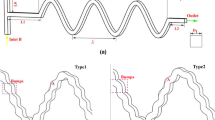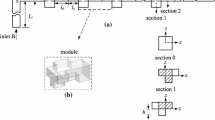Abstract
This article reports a novel design of a micromixer showing efficient mixing by creating vortex flow in a microchannel. The main microchannel splits and recombines into two sub-channels at a tangential position that facilitates the generation of vortex flow. The height and width of the sub-channels are half the height and width of the main microchannel. The fluid flow and the mixing characteristics of the micromixer were demonstrated by performing numerical and experimental studies at different Reynolds numbers (Re = 2.5≈40). The micromixer was fabricated using a standard soft lithography process. The fluid streams from the subchannels create vortex flow in the main microchannel which increases the interface area. The idea of creating multiple vortex flow zones by repeating the design of vortex T-mixer was successfully shown in mixing enhancement. The design of the micromixer is promising for mixing the fluids in a short length of the microchannel (5.5 mm at Re = 10 and 2.6 mm at Re = 40).
Similar content being viewed by others
References
H. A. Stone, A. D. Stroock and A. Ajdari, Engineering flows in small devices: Microfluidics toward a lab-on-a-chip, Ann. Rev. Fluid Mech., 36 (2004) 381–411.
M. A. Burns, B. N. Johnson, S. N. Brahmasandra, K. Handique, J. R. Webster, M. Krishnan, T. S. Sammarco, P. M. Man, D. Jones, D. Heldsinger, C. H. Mastrangelo and D. T. Burke, An integrated nanoliter DNA analysis device, Science, 282 (1998) 484–487.
N. T. Nguyen and Z. G. Wu, Micromixers - A review, J. Micromech. Microeng., 15 (2005) R1–R16.
V. Hessel, H. Lowe and F. Schonfeld, Micromixers - A review on passive and active mixing principles, Chem. Eng. Sci., 60 (2005) 2479–2501.
A. Soleymani, E. Kolehmainen and I. Turunen, Numerical and experimental investigations of liquid mixing in T-type micromixers, Chem. Eng. J., 135 (2008) S219–S228.
D. Bothe, C. Sternich and H. J. Warnecke, Fluid mixing in a T-shaped micro-mixer, Chem. Eng. Sci., 61 (2006) 2950–2958.
S. Thomas, T. Ameel and J. Guilkey, Mixing kinematics of moderate Reynolds number flows in a T-channel, Phys. Fluids, 22 (2010) 031601.
A. D. Stroock, S. K. W. Dertinger, A. Ajdari, I. Mezic, H. A. Stone and G. M. Whitesides, Chaotic mixer for micro-channels, Science, 295 (2002) 647–651.
T. J. Johnson, D. Ross and L. E. Locascio, Rapid micro-fluidic mixing, Anal. Chem., 74 (2002) 45–51.
R. H. Liu, M. A. Stremler, K. V. Sharp, M. G. Olsen, J. G. Santiago, R. J. Adrian, H. Aref and D. J. Beebe, Passive mixing in a three-dimensional serpentine microchannel, J. Microelectromech. Syst., 9 (2000) 190–197.
F. G. Bessoth, A. J. deMello and A. Manz, Microstructure for efficient continuous flow mixing, Anal. Comm., 36 (1999) 213–215.
C. K. Chung and T. R. Shih, A rhombic micromixer with asymmetrical flow for enhancing mixing, J. Micromech. Microeng., 17 (2007) 2495–2504.
C. C. Hong, J. W. Choi and C. H. Ahn, A novel in-plane passive microfluidic mixer with modified Tesla structures, Lab Chip, 4 (2004) 109–113.
Z. Lu, J. McMahon, H. Mohamed, D. Barnard, T. R. Shaikh, C. A. Mannella, T. Wagenknecht and T. M. Lu, Passive microfluidic device for submillisecond mixing, Chem. Eng. J., 141 (2009) 301–309.
M. A. Ansari, K. Y. Kim, K. Anwar and S. M. Kim, A novel passive micromixer based on unbalanced splits and collisions of fluid streams, J. Micromech. Microeng., 20 (2010) 055007.
M. A. Ansari and K.-Y. Kim, Mixing performance of unbalanced split and recombine micomixers with circular and rhombic sub-channels, Chem. Eng. J., 162 (2010) 760–767.
N. Schwesinger, T. Frank and H. Wurmus, A modular microfluid system with an integrated micromixer, J. Micromech. Microeng., 6 (1996) 99–102.
F. Schonfeld, V. Hessel and C. Hofmann, An optimised split-and-recombine micro-mixer with uniform ‘chaotic’ mixing, Lab Chip, 4 (2004) 65–69.
H. Chen and J. C. Meiners, Topologic mixing on a micro-fluidic chip, App. Phys. Let., 84 (2004) 2193–2195.
D. S. Kim, S. H. Lee, T. H. Kwon and C. H. Ahn, A serpentine laminating micromixer combining splitting/recombination and advection, Lab Chip, 5 (2005) 739–747.
C. Simonnet and A. Groisman, Chaotic mixing in a steady flow in a microchannel, Phys. Rev. Lett., 94 (2005) 134501.
H. M. Xia, S. Y. M. Wan, C. Shu and Y. T. Chew, Chaotic micromixers using two-layer crossing channels to exhibit fast mixing at low Reynolds numbers, Lab Chip, 5 (2005) 748–755.
J. M. Park, D. S. Kim, T. G. Kang and T. H. Kwon, Improved serpentine laminating micromixer with enhanced local advection, Microfluid. Nanofluid., 4 (2008) 513–523.
S. Hossain, I. Lee, S. M. Kim and K. Y. Kim, A micromixer with two-layer serpentine crossing channels having excellent mixing performance at low Reynolds numbers, Chem. Eng. J., 327 (2017) 268–277.
W. Raza, S. Hossain and K. Y. Kim, Effective mixing in a short serpentine split-and-recombination micromixer, Sensors and Actuators B, 258 (2018) 381–392.
Y. C. Chung, Y. L. Hsu, C. P. Jen, M. C. Lu and Y. C. Lin, Design of passive mixers utilizing microfluidic self-circulation in the mixing chamber, Lab Chip, 4 (2004) 70–77.
M. A. Ansari and K. Y. Kim, A numerical study of mixing in a microchannel with circular mixing chambers, AIChE J., 55 (2009) 2217–2225.
C. H. Lin, C. H. Tsai and L. M. Fu, A rapid three-dimensional vortex micromixer utilizing self-rotation effects under low Reynolds number conditions, J. Micromech. Microeng., 15 (2005) 935–943.
C. H. Lin, C. H. Tsai, C. W. Pan and L. M. Fu, Rapid circular microfluidic mixer utilizing unbalanced driving force, Biomed. Microdev., 9 (2007) 43–50.
ANSYS. Solver Theory Guide; CFX-15.0, ANSYS Inc., Canonsburg, PA, USA (2015).
M. A. Ansari, K. Y. Kim, K. Anwar and S. M. Kim, Vortex micro T-mixer with non-aligned inputs, Chem. Eng. J., 181–182 (2012) 846–850.
M. A. Ansari, K. Y. Kim and S. M. Kim, Numerical and experimental study on mixing performances of simple and vortex micro T-mixers, Micromachines, 9 (2018) 204.
Author information
Authors and Affiliations
Corresponding authors
Additional information
Recommended by Associate Editor Jinkee Lee
Mubashshir Ahmad Ansari is an Associate Professor in the Department of Mechanical Engineering, Aligarh Muslim University (AMU), India, since May 2016. He completed B. Tech. and M. Tech. in Mechanical Engineering from AMU, Aligarh and earned his Ph.D. (2009) from Inha University, South Korea. He worked as an Assistant Professor in Inha university for two years after completion of his Ph.D. He has postdoctoral research experience of more than four years in three different universities in South Korea (Sogang University, Korea Advanced Institute of Science and Technology (KAIST) and Gwangju Institute of Science and Technology (GIST). His research area is in the field of MEMS/Microfluidics (mixing at micromixer, design of micromixers, separation of particles). His current work is on the mixing of fluids at microscale and separation of rare cells using the surface acoustic waves in a microfluidics system.
Kwang-Yong Kim received his B.S. degree from Seoul National University in 1978, and his M.S. and Ph.D. degrees from the Korea Advanced Institute of Science and Technology (KAIST), Korea, in 1981 and 1987, respectively. He is currently a Dean of Engineering College and Inha Fellow Professor in the Department of Mechanical Engineering of Inha University, Incheon, Korea. Professor Kim is also the current Editor-in-Chief of the International Journal of Fluid Machinery and Systems, the Associate Editor of ASME Journal of Fluids Engineering, and the Chairman of the Asian Fluid Machinery Committee. He served as the Editor-in-Chief of the Transactions of Korean Society of Mechanical Engineers and President of Korean Society for Fluid Machinery. He is also a fellow of the Korean Academy of Science and Technology, a fellow of the American Society of Mechanical Engineers (ASME) and an associate fellow of the American Institute of Aeronautics and Astronautics (AIAA). He is interested in applications of the numerical optimization techniques using various surrogate models and computational fluid dynamics to the designs of fluid machinery, heat-transfer augmentation devices, micro heat sinks, micro mixers, coolant channels in nuclear reactors, etc. He has published about 374 peer-reviewed journal papers, and presented about 546 papers at international/domestic conferences.
Sun Min Kim received his B.S. (1997) and M.S. (1999) degrees in mechanical engineering from the Seoul National University, Korea, and an M.S. degree in biomedical engineering and his Ph.D. degree in mechanical engineering from the University of Michigan, Ann Arbor in 2005 and 2006, respectively. In 2007, he joined the Faculty ofthe Department of Mechanical Engineering, Inha University, Korea, following post-doctoral work at the Brigham and Women's Hospital, Harvard Medical School, MA. He is interested in the fundamental understanding and development of micro/nanofluidic systems for biochemical sample analysis, cell-based biosensor, and organs-on-chips.
Rights and permissions
About this article
Cite this article
Ansari, M.A., Kim, KY. & Min, S. Integrated vortex micro T-mixer for rapid mixing of fluids. J Mech Sci Technol 33, 5923–5931 (2019). https://doi.org/10.1007/s12206-019-1137-9
Received:
Revised:
Accepted:
Published:
Issue Date:
DOI: https://doi.org/10.1007/s12206-019-1137-9




